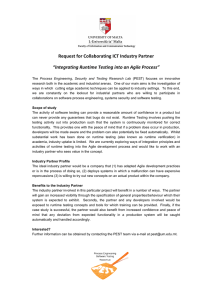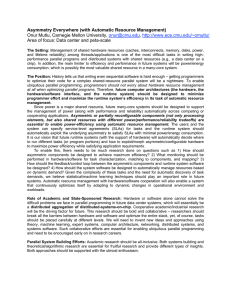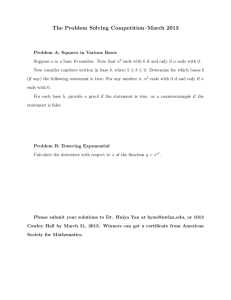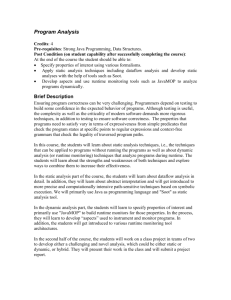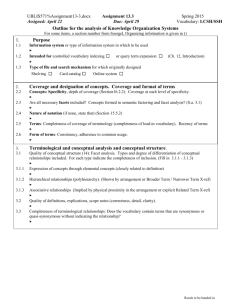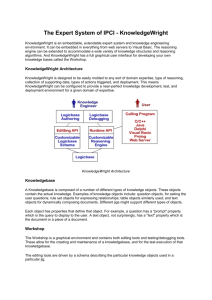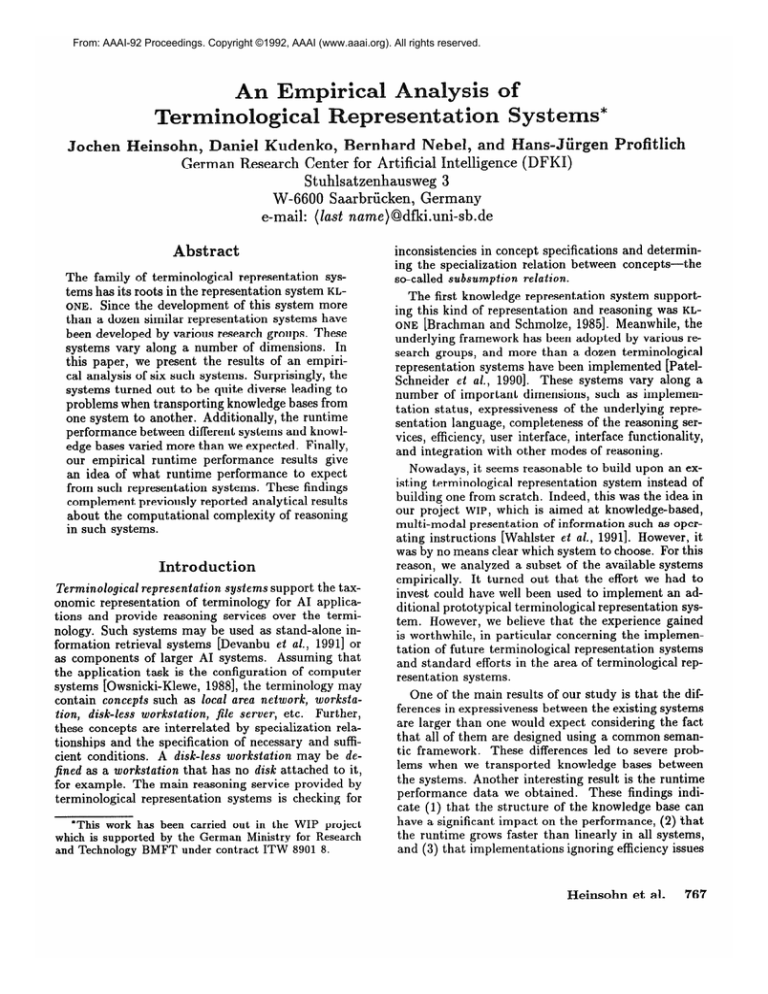
From: AAAI-92 Proceedings. Copyright ©1992, AAAI (www.aaai.org). All rights reserved.
German Research Center for Artificial Intelligence
Stuhlsatzenhausweg 3
W-6600 Saarbriicken, Germany
e-mail: (last name)@dfki.uni-sb.de
Abstract
The family of terminological representation systems has its roots in the representation system KLONE. Since the development of this system more
than a dozen similar representation systems have
been developed by various research groups. These
systems vary along a number of dimensions. In
this paper, we present the results of an empirical analysis of six such systems. Surprisingly, the
systems turned out to be quite diverse leading to
problems when transporting knowledge bases from
one system to another. Additionally, the runtime
performance between different systems and knowledge bases varied more than we expected. Finally,
our empirical runtime performance results give
an idea of what runtime performance to expect
from such representation systems. These findings
complement previously reported analytical results
about the computational complexity of reasoning
in such systems.
Introduction
systems support the taxonomic representation of terminology for AI applications and provide reasoning services over the terminology. Such systems may be used as stand-alone information retrieval systems [Devanbu et al., 19911 or
as components of larger AI systems. Assuming that
the application task is the configuration of computer
systems [Owsnicki-Klewe, 19881, the terminology may
contain concepts such ils local area network, workstation, disk-less workstation, file server, etc. Further,
these concepts are interrelated by specialization relationships and the specification of necessary and sufficient conditions. A disk-less workstation may be defined m a workstation that has no disk attached to it,
for example. The main reasoning service provided by
terminological representation systems is checking for
Terminological
rofitlich
ernhard Nebel, an
Jochen
representation
*This work has been carried out in the WIP project
which is supported
by the German
Ministry for Research
and Technology
BMFT
under contract ITW 8901 8.
(DFKI)
inconsistencies in concept specifications and determining the specialization relation between concepts-the
so-called subsumption relation.
The first knowledge representation system supporting this kind of representation and reasoning was KLONE [Brachman and Schmolze, 19851. Meanwhile, the
underlying framework has been adopted by various research groups, and more than a dozen terminological
representation systems have been implemented [PatelSchneider et al., 19901. These systems vary along a
number of important dimensions, such as implementation status, expressiveness of the underlying representation language, completeness of the reasoning services, efficiency, user interface, interface functionality,
and integration with other modes of reasoning.
Nowadays, it seems reasonable to build upon an existing terminological representation system instead of
building one from scratch. Indeed, this was the idea in
our project WIP, which is aimed at knowledge-based,
multi-modal presentation of information such as operating instructions [Wahlster et al., 19911. However, it
was by no means clear which system to choose. For this
reason, we analyzed a subset of the available systems
empirically. It turned out that the effort we had to
invest could have well been used to implement an additional prototypical terminological representation system. However, we believe that the experience gained
is worthwhile, in particular concerning the implementation of future terminological representation systems
and standard efforts in the area of terminological representation systems.
One of the main results of our study is that the differences in expressiveness between the existing systems
are larger than one would expect considering the fact
that all of them are designed using a common semantic framework. These differences led to severe problems when we transported knowledge bases between
the systems. Another interesting result is the runtime
performance data we obtained. These findings indicate (1) that the structure of the knowledge base can
have a significant impact on the performance, (2) that
the runtime grows faster than linearly in all systems,
and (3) that implementations
ignoring efficiency issues
Heinsohn et al.
767
can be quite slow. Additionally, the performance data
gives an idea of what performance to expect from existing terminological representation systems. These results complement the various analytical results on the
computational complexity of terminological reasoning.
The Experiment
The empirical analysis can be roughly divided into two
parts (see Figure l).l The first part covers qualitative
facts concerning system features and expressiveness. In
order to describe the latter aspect, we first developed
a “common terminological language” that covers a superset of all terminological languages employed in the
systems we considered. The analysis of the expressiveness shows that the intersection over all representation
languages used in the systems is quite small.
l&l
c
Exprossivomss
Manual8
Problwnatioal Cases (20)
Obvious Inforonoos (20)
Real KBs (6)
100-400 oonoapts
Random KEs (30)
154000 oonoopta
Figure 1: Experiment design
In the second part we ran different test cases on the
systems in order to check out the performance, completeness and the handling of problematical cases. We
designed five different groups of experiments. The first
group consists of tests dealing with cases that are not
covered by the common semantic framework of terminological representation systems. The second group
explores the degree of the inferential completeness of
the systems for “easy” (i.e., polynomial) inferences. It
should be noted that we did not try to design these
tests in a systematic fashion by trying out all possible combinations of language constructs, though. The
third group consists of problems which are known to be
“hard” for existing systems. They give an impression
of the runtime performance under worst-case conditions.
For the fourth group of experiments we used existing
knowledge bases to get an idea of the runtime performance under “realistic” conditions. First, we manually converted the knowledge bases into the “common
terminological language” mentioned above. Then, we
implemented a number of translators that map the
‘The details of the experiment are given in a technical
report [Heinsohn et al., 19921.
768
Represent
at ion and Reasoning:
Terminological
knowledge bases formulated using the “common terminological language” into system specific knowledge
bases.
Although the results of the fourth group of experiments give some clues of what the behavior of the systems may be in applications, we had not enough data
points to confirm some of the conjectures that resulted
from this initial test under realistic conditions. Additionally, it was not evident in how far the translation,
which is only approximate, influenced the performance.
For this reason, a fifth group of experiments was designed. A number of knowledge bases were generated
randomly with a structure similar to the structure of
the realistic knowledge bases.
In general, we concentrated on the terminological
representation
part (also called TBoc) of the systems.
This means that we ignored other representation and
reasoning facilities, such as facilities for maintaining
and manipulating databases of objects (also called
ABox) that are described by using the concepts represented in the terminological knowledge base. This concentration on the terminological component is partly
justified by the fact that the terminological part is the
one which participates in most reasoning activities of
the entire system. Thus, run time performance and
completeness of the terminological part can be generalized to the entire system-to
a certain degree. However, the systems may (for efficiency reasons) use different algorithms for maintaining a database of objects,
which may lead to a different behavior in this case.
Nevertheless, even if the generalization is not valid in
general, we get at least a feeling how the terminological
parts perform.
As a final note, we want to emphasize that our empirical analysis was not intended to establish a ranking between the systems. For this purpose, it would
be necessary to assign weights to the dimensions we
compared, and this can only be done if the intended
application has been fixed. Despite the fact that we
analyzed only the terminological subsystems, the tests
are not intended to be complete in any sense and there
may be more dimensions that could be used to analyze the systems. Further, the results apply, of course,
only to the system versions explicitly mentioned in the
following section. The system developers of a number of systems have improved their systems since we
made our experiment. So, the runtime performance
may have changed.
Systems
There are a large number of systems which could have
been included in an empirical analysis, e.g., KL-ONE,
LILOG, NIKL, K-REP, KRS, KRYPTON, and YAK (seee.g.
[Patel-Schneider et al., 1990; Nebel et al., 19911). Mowever, we concentrated on a relatively small number of
systems. This does not mean that we feel that the systems we did not include (or mention) are not worthwhile to be analyzed. The only reason not to include all
the systems was the limited amount of time available.
We hope, however, that our investigation can serve as
a starting point for future empirical analyses. The systems we picked for the experiment are: BACK [Peltason, 19911 (V ersion 4.2, pre-released), CLASSIC [PatelSchneider et al., 19911 (Version 1.02, released), KRIS
[Baader and Hollunder, 19911 Version 1.O, experimen1991f (Version of May 1990,
wsnicki-Klewe, 19SS] (Version
2.0, released), and SB-ONE [Kobsa, 19911 (Version of
January 1990, released).
The BACK system has been developed at the Technical University of Berlin by the KIT-BACK group as
part of the Esprit project ADKMS. The main application is an information system about the financial and
organizational structure of a company [Damiani et al.,
19901. It is the only system among the ones we tested
that is written in PROLOG. We tested the system on a
Solbourne 601/32 using SICSTUS-PROLOG 2.1.
CLASSIC has been developed in the AI Principles Research Department at AT&T Bell Laboratories. It supports only a very limited terminological language, but
turned out to be very useful for a number of applications [Devanbu et al., 19911. As all other systems
except for BACK, it is written in COMMONLISP
and we
tested it on a MacIvory.
KRIS has been developed by the WIN0 project
at DFKI. In contrast to other systems, it provides
complete inference algorithms for very expressive languages. Efficiency considerations have played no role
in the development of the system.
LOOM has been developed at USC/IS1 and supports
a very powerful terminological logic-in an incomplete
manner, though-and offers the user a very large number of features. In fact, LOOM can be considered as a
programming environment.
MESON has been developed at the Philips Research
Laboratories, Hamburg, as a KR tool for different
applications, e.g., computer configuration [OwsnickiKlewe, 19881. Although it is also written in COMMONLISP, we tested it not on a MacIvory but on a Solbourne 601/32 in order to take advantage of its nice
X-Window interface.
SB-ONE has been developed in the XTRA project
at the University of Saarland as the knowledge representation tool for a natural language project. One of
the main ideas behind the design of the system was
the possibility of direct graphical manipulations of the
represented knowledge.
ualitative
esu1ts
The main qualitative result of our experiment is that
although the systems were developed with a common
framework in mind, they are much more diverse than
one would expect. First of all, the terminological languages that are supported by the various systems are
quite different. While three of the six systems use a
similar syntactic scheme (similar to the one first used
by Brachman and Levesque [Brachman and Levesque,
1984]), and one system adapted this syntactic scheme
for PROLOG, i.e., infix instead of prefix notation, the
remaining two systems use quite different syntactic
schemes. Furthermore, there are not only superficial
differences in the syntax, but the set of (underlying)
term-forming
operators varies, as well. In fact, the
common intersection of all languages we considered is
quite small. It contains only the concept-forming operators concept conjunction, value restriction, and number restriction.2
These differences led to severe problems when we designed automatic translators from the “common terminological language” to the languages supported by the
different systems. Because of the differences in expressiveness, the translations could only be approximate,
and because of the differences in the syntax we used a
translation schema that preserved the meaning (as far
as possible) but introduced a number of auxiliary concepts. Using the translated knowledge bases, we noticed that the introduction of auxiliary concepts influences the runtime performance significantly-a
point
we will return to.
Discounting the differences in syntax and expressiveness, one might expect that the common semantic
framework (as spelled out by Brachman and Levesque
[Brachman and Levesque, 19841) leads to identical
behavior on inputs that have identical meaning and
match the expressiveness of the systems. Bowever,
this is unfortunately wrong. When a formal specification is turned into an implemented system, there are
a number of areas that are not completely covered by
the specification. One example is the order of the input. So, some systems allow for forward references in
term definitions and some do not. Furthermore, some
systems support cyclic definitions (without handling
them correctly according to one of the possible semantics [Nebel, 19911, however, or permitting cyclic definitions only in some contexts), and some give an error
message. Also redefinitions of terms are either marked
as errors, processed as revisions of the terminology,
or treated as incremental additions to the definition.
Finally, there are different rules for determining
the
syntactic category of an input symbol.
Another area where designers of terminological systems seem to disagree is what should be considered as
a an error by the user. So, some systems mark the definitions of semantically equivalent concepts as an error
or refuse to accept semantically empty (inconsistent)
concepts, for instance.
These differences between the systems made the
translation from the “common terminological language” to system-specific languages even more complicated. In fact, some of the problems mentioned above
were only discovered when we ran the systems on the
2The technical
report [Heinsohn
et al., 19921 contains
tables specifying precisely the expressiveness
of the different systems.
Heinsohn
et al.
769
translated knowledge bases. We solved that problem
by putting‘the source form of the knowledge base into
the most unproblematical form, if possible, or ignored
problematical constructions (such as cyclic definitions)
in the translation process.
Summarizing, these results show that the ongoing
process of specifying a common language for terminological representation and reasoning systems [Neches et
al., 1991, p. 50-511 will probably improve the situation
in so far as the translation of knowledge bases between
different systems will become significantly easier. One
main point to observe, however, is the area of pragmatics we touched above, such as permitting forward
references.
Finally, we should mention a point which all systems had in common. In each system we discovered at
least one deviation from the documentation, such as
missing an obvious inference or giving a wrong error
message. This is, of course, not surprising, but shows
that standard test suites should be developed for these
systems.
There are a number of other dimensions where the
systems differ, such as the integration with other reasoning services, the functionality of graphical user interfaces, ease of installation, and user friendliness, but
these are issues which are very difficult to evaluate.
One important feature of a representation and reasoning system is, of course, its runtime performance.
In the case of terminological representation systems,
the time to compute the subsumption
hierarchy of
concepts -a process that is often called classificationis an interesting parameter. In order to get a feeling
for the runtime behavior of the systems we designed
several tests to explore how the systems behave under different conditions. Since most of the systems are
still under development, the runtime data we gathered
is most probably not an accurate picture of the performance of the most recent versions of the systems, In
particular, new (and faster) versions Of BACK, CLASSIC,
and LOOM are available.
Computational complexity results show that subsumption
determination
between terms is NP-hard
[Donini et al., 19911 or even undecidable [SchmidtSchauf3, 19891 for reasonably expressive languages.
Even assuming that term-subsumption
can be computed in polynomial time (e.g., for restricted languages), subsumption determination in a terminology
is still NP-hard [Nebel, 19901. In order to explore this
issue, we designed some tests to determine the behavior of the systems under conditions that are known to
be hard.
One test exploits the NP-hardness result for termsubsumption for languages that contain conceptconjunction, value restrictions, and qualified existential restrictions [Donini et al., 19921. It turned out that
three systems could not express this case, one system
Represent
at ion and Reasoning:
8000
R
U
;
6000
i
m
e
* 4000
e
C
Quantitative Results
770
renorted an internal error, one system missed the infeience (but exhibited a polynomial runtime behavior),
and only one system handled the case, but with a very
rapid growth in runtime.
Three other tests exploit the NP-hardness result for
subsumption in terminologies [Nebel, 19901. The first
two tests show that only one of the six systems uses a
naive way of performing subsumption in a terminology
by expanding all concept definitions before checking
subsumption [Nebel, 1990, p. 2391. The third test was
designed in a way such that also clever subsumption
algorithms are bound to use exponential time [Nebel,
1990, p. 2451. Th e results of the latter test are given
in Figure 2. 3 They clearly indicate that the systems
indeed exhibit a very rapid growth in the runtime.
Terminological
16
24
No. of concepts
32
40
Figure 2: Runtime performance for hard cases
Despite their theoretical intractability, terminological reasoning systems have been used for’quite a while
and the literature suggests that the knowledge bases
involved were larger than just toy examples (i.e., more
than 40 concepts). Hence, one would a&ume that the
knowledge bases’that have been used in applications
are of a form that permits easy inferences, br the systems are incomplete and ignore costly inferences. In
any case, it is questionable of whether the runtime performance for worst-case examples give us the right idea
of how systems will behave in applications.
In order to get a feeling of the runtime performance
under “realist&” conditions, we asked other research
groups for terminological knowledge bases they use
3The runtimes of BACK and MESON are not directly comparable with the other systems because BACK and MESON
were tested on a Solbourne
601/32, which is two to three
times faster than a MacIvory
with respect
to the execution of COMMONLISP programs,
a remark that applies also
to the other runtime performance
tests.
Additionally,
it
is not clear to us in how far the performance
of BACK is
influenced by the fact that it is implemented
in PROLOG.
250
@BACK
0 CLASSIC
,g, KRIS
( x20)
@LOOM
o MESON
0 SB-ONE
R
( x20)
U
y 150
m
e
s
e
i
m
e
200
C
100
30
No. of concepts
Figure 3: Runtime performance for realistic cases
Doing so, we obtained six differin their projects.
ent knowledge bases. As mentioned above, these were
first manually translated into the “common terminological language” and then translated to each target
language using our (semi-) automatic translators. In
Figure 3, the runtime for the systems is plotted against
the number of concepts defined in the different knowledge bases.
There are a number of interesting points to note
here. First of all, two systems, namely, KRIS and SBONE, were too slow to be plotted together with the
other systems using the same scale. For this reason, we
divided the runtimes by the factor of 20 before plotting
it.
Second, the diagram indicates that the runtime ratio
between the slowest system (KRIS) and the fastest system (CLASSIC) in case of the largest knowledge base is
extreme, namely, 45,000/56 x 800. Considering that
KRIS was developed as an experimental testbed for different complete subsumption algorithms and CLASSIC
was designed as an efficient system for an expressively
limited language to be used in different applications,
this result is actually not completely surprising. It
would be of course desirable to explain this and other
differences in performance on the level of algorithms
and implementation techniques. However, these issues
are not described in the literature and a source code
analysis was beyond the scope of our analysis.
Third, the knowledge base with 210 concepts seems
to be somehow special because the runtime curve shows
a peak at this point. Inspecting this knowledge base,
we discovered that one concept is declared to be superconcept (i.e, mentioned literally in the definition) of
50% of all other concepts. Removing this concept led
to a smoother curve. Hence, the structure of a knowledge base can severely influence the runtime. Although
this should have been obvious already from the first
diagram showing the runtime behavior under worst-
60
90
No. of concepts
120
150
Figure 4: Runtime performance for small random KBs
2500
2000
R
U
p 1500
m
e
s 1000
e
C
500
No. of concepts
Figure 5: Runtime performance for large random KBs
case conditions, it is an indication that under realistic
conditions the runtime behavior can be unexpectedly
influenced by the structure of the knowledge base.
Summarizing the curves in Figure 3, it seems to be
the case that most of the systems, except for SB-ONE,
are similar in their runtime behavior in that the same
knowledge bases are considered as “difficult” or “easy”
to a similar degree. However, it is not clear whether
the system runtimes differ only by a constant factor
or not. Further, because of the approximative nature
of the translations and the introduction of auxiliary
concepts, it is not clear to us how reliable the data is.
For these reasons, we generated knowledge bases randomly in the intersection of all languages-avoiding
the translation problem. The structure of these generated knowledge bases resembles the structure of the
six real knowledge bases (percentage of defined concepts, average number of declared super-concepts, avHeinsohn et al.
771
Another conclusion of our runtime tests could be
that the more expressive and complete a system is,
the slower it is-with
KRIS as a system supporting
complete inferences for a very expressive language and
CLASSIC with almost complete inferences for a comparably simple language at the extreme points. However,
we do not believe that this is a necessury phenomenon.
A desirable behavior of such systems is that the user
would have “to pay only as s/he goes,” i.e., only if the
full expressive power is used, the system is slow. In
fact, at DFKI together with the WIN0 group we are
currently working on identifying the performance bottlenecks in the KRIS system. First experiences indicate
that it is possible to come close to the performance of
LOOM and CLASSIC for the knowledge bases used in our
tests.
R
U
n
t
6000
m
e
8
e
4000
C
1000
2000
3000
No. of concepts
4000
5000
Figure 6: Runtime performance for very large random
KBs
erage number of role restrictions, etc.). The results of
this test are given in Figures 4, 5, and 6.
Comparing the curves in these three figures with the
curves in Figure 3, it seems to be the case that the
structure of the randomly generated knowledge bases
is indeed similar to the structure of realistic knowledge
bases in so far as they lead to a similar runtime performance. However, we do not claim that the knowledge
bases are realistic with respect to all possible aspects.
In fact, too few facts are known about which structural properties can influence the performance of terminological representation systems. Bob MacGregor,
for instance, reported that the number of distinct roles
heavily influence the performance. He observed that
the runtime decreases when the number of distinct roles
is increased and all other parameters are hold constant
(same number of concepts and role restrictions).
These curves indicate that the runtime grows faster
than linearly with the number of concepts. We conjecture that in general the runtime of terminological
representation systems is at least quadratic in the number of concepts. This conjecture is reasonable because
identifying a partial order over a set of elements that
are ordered by an underlying partial order is worst-case
quadratic (if all elements are incomparable), and there
is no algorithm known that is better for average cases.
In fact, average case results are probably very hard to
obtain because it is not known how many partial orders exist for a given number of elements [Aigner, 1988,
p. 2711.
From this, we conclude that designing efficient terminological representation systems is not only a matter
of designing efficient subsumption algorithms, but also
a matter of designing efficient chssijicution algorithms,
i.e., fast algorithms that construct a partial order. The
main point in this context is to minimize the number
of subsumption tests.
772
Representation
and Reasoning:
Terminological
Conclusions
We have analyzed six different terminological representation and reasoning systems from a qualitative and
quantitative point of view. The empirical analysis of
the different terminological languages revealed that the
common intersection of the languages supported by the
systems is quite small. Together with the fact that the
systems behave differently in areas that are not covered
by the common semantic framework, sharing of knowledge bases between the systems does not seem to be
easily achievable. In fact, when we tried to translate
six different knowledge bases from a “common terminological language” into the system-specific languages
we encountered a number of problems.
Testing the runtime performance of the systems, we
noted that the structure of the knowledge base can
have a significant impact on the performance, even
if we do not consider artificial worst-case examples
but real knowledge bases. Further, the systems varied considerably in their runtime performance.
For
instance, the slowest system was approximately 1000
times slower than the fastest in one case. The overall
picture suggests that for all systems the runtime grows
at least quadratically with the size of the knowledge
base. These findings complement the various analyses
of the computational complexity, providing a user of
terminological systems with a feeling of how much he
can expect from such a system in reasonable time.
Acknowledgments
We would like to thank the members of the research
groups KIT-BACK at TU Berlin, AI Principles Research Department at Bell Labs., WIN0 at DFKI,
LOOM at USC/ISI, MESON at Philips Research Laboratories, and XTRA at the University of Saarland, for
making their systems and/or knowledge bases available to us, answering questions about their systems,
and providing comments on an earlier version of this
paper. Additionally we want to express our thanks to
Michael Gerlach, who made one of the knowledge bases
available to us.
Aigner, Martin 1988. Combinatorical
ner, Stuttgart, Germany.
Search. Teub-
Baader, Franz and Hollurader, Bernhard 1991. KRIS:
Knowledge representation and inference system.
SIGART
Bulletin 2(3):8-14.
Brachman, Ronald 9. and Levesque, Hector J. 1984.
The tractability of subsumption in frame-based description languages. In Proceedings of the 4th National Conference
of the American
Association
Artificial Intelligence,
Austin, TX. 34-37.
for
Brachman, Ronald J. and Schmolze, James G. 1985.
An overview of the ML-ONE knowledge representation system. Cognitive Science 9(2):171-216.
Damiani, M.; Bottarelli, S.; Migliorati, M.; and Peltason, C. 1990. Terminological Information Management in ADKMS. Hn ESPRIT
‘90 Conference
Proceedings, Dordrecht , Holland. Kluwer .
Devanbu, Premkumar T.; Brachman, Ronald J.;
Selfridge, Peter G.; and Ballard, Bruce W. 1991.
LaSSIE: a knowledge-based software information system. Communications
of the ACM 34(5):35-49.
Donini, Francesco M. ; Lenzerini, Maurizio; Nardi,
Daniele; and Mutt, Werner 1991. The complexIn Allen, James A.;
ity of concept languages.
Fikes, Richard; and Sandewall, Erik, editors 1991,
Principles
of Knowledge Representation
ing: Proceedings of the 2nd International
and ReasonConference,
Cambridge, MA. Morgan Kaufmann. 151-162.
Donini, Francesco M . ; Lenzerini, Maurizio; Nardi,
Daniele; Hollunder, Bernhard; Mutt, Werner; and
Spacamella, Albert0 Marchetti 1992. The complexity of existential quantification in concept languages.
Artificial
Intelligence
53(2-3):309-327.
Heinsohn, Jochen; Kudenko, Daniel; Nebel, Bernhard; and Profitlich, Hans-Jiirgen 1992. An empirical analysis of terminological representation systems. DFKI Research Report RR-92-16, German
Research Center for Artificial Intelligence
(DFKI),
Saarbriicken.
Kobsa, Alfred 1991. First experiences with the SBONE knowledge representation workbench in naturallanguage applications. SIGART Bulletin 2(3):70-76.
Nebel, Bernhard 1990. Terminological reasoning is
inherently intractable. Artificial Intelligence 43:235249.
Nebel, Bernhard 1991. Terminological cycles: Semantics and computational properties. In Sowa, John F.,
editor 1991, Principles of Semantic Networks. Morgan Kaufmann, San Mateo, CA. 331-362.
Neches, Robert; Fikes, Richard; Finin, Tim; Gruber,
Thomas; Patil, Ramesh; Senator, Ted; and Swartout,
William R. 1991. Enabling technology for knowledge
sharing. The AI Magazine 12(3):36-56.
Owsnicki-Klewe, Bernd 1988. Configuration as a consistency maintenance task. In Hoeppner, Wolfgang,
editor 1988, Kzinstliche Intelligent.
GWAI-88,
12.
Jahrestagung,
Eringerfeld, Germany. Springer-Verlag.
77-87.
Patel-Schneider, Peter F. ; Owsnicki-Klewe, Bernd;
Kobsa, Alfred; Guarino, Nocola; MacGregor, Robert;
Mark, William S.; McGuinness, Deborah; Nebel,
Bernhard; Schmiedel, Albrecht; and Yen, John 1990.
Term subsumption languages in knowledge representation. The AI Magazine 11(2):16-23.
Patel-Schneider, Peter F.; McGuinness, Deborah L.;
Brachman, Ronald J.; Alperin Resnick, Lori; and
Borgida, Alex 1991. The CLASSIC knowledge representation system: Guiding principles and implementation rational. SIGART Bulletin 2(3):108-113.
Peltason, Christof 1991. The BACK system - an
overview. SIGART Bulletin 2(3):114-119.
Schmidt-Schau& Manfred 1989. Subsumption in KLONE is undecidable. In Brachman, Ron J.; Levesque,
Hector J.; and Reiter, Ray, editors 1989, Principles
of Knowledge
Representation
ceedings of the 1st International
Proand Reasoning:
Conference,
Toronto,
ON. Morgan Kaufmann. 42 l-43 1.
Wahlster, Wolfgang; Andre, Elisabeth; Bandyopadhyay, Som; Graf, Winfried; and Rist, Thomas 1991.
WIP: the coordinated generation of multimodal presentations from a common representation. In Ortony,
Andrew; Slack, John; and Stock, Oliviero, editors
1991, Computational
Theories of Communication
and
their Applications.
Springer-Verlag, Berlin, Heidelberg, New York. To appear. Also available as DFKH
Research Report RR-91-08.
MacGregor, Robert 1991. Inside the LOOM description classifier. SIGART Bulletin 2(3):88-92.
Nebel, Bernhard; von Luck, Kai; and Peltason,
Christof, editors 1991. International workshop on terminological logics. DFKI Document D-91-13, German
Research Center for Artificial Intelligence (DFKI),
Saarbriicken.
Also published as KIT Report, TU
Berlin, and IWBS Report, IBM Germany, Stuttgart.
Meinsohn
et al.
773

